This article needs additional citations for verification .(October 2021) |
| Atchison, Topeka & Santa Fe #5 Little Buttercup | |||||||||||||||||
|---|---|---|---|---|---|---|---|---|---|---|---|---|---|---|---|---|---|
 | |||||||||||||||||
| |||||||||||||||||
| |||||||||||||||||
| |||||||||||||||||
| |||||||||||||||||
Atchison, Topeka & Santa Fe No. 5 Little Buttercup (former ATSF #2419, Santa Fe Terminal #1) is an 0-4-0 steam locomotive.
This article needs additional citations for verification .(October 2021) |
| Atchison, Topeka & Santa Fe #5 Little Buttercup | |||||||||||||||||
|---|---|---|---|---|---|---|---|---|---|---|---|---|---|---|---|---|---|
 | |||||||||||||||||
| |||||||||||||||||
| |||||||||||||||||
| |||||||||||||||||
| |||||||||||||||||
Atchison, Topeka & Santa Fe No. 5 Little Buttercup (former ATSF #2419, Santa Fe Terminal #1) is an 0-4-0 steam locomotive.
"Little Buttercup" was originally built in 1899 by the Baldwin Locomotive Works as an 0-4-0 saddle tank locomotive for the Santa Fe Terminal Railway as their #1. The SFT was a subsidiary of the Atchison, Topeka & Santa Fe Railway, operating under the moniker of the San Francisco & San Joaquin Valley Railway, was designed to run a terminal operation in the China Basin around San Francisco, California. It was absorbed into the ATSF system in 1902, and SFT #1 became ATSF #2419. [1] She was then moved to the shops at Needles, California to work there as the "shop goat," and was renumbered at least 3 more times till finally running with the road number #9419 in 1948.

That same year was the Chicago Railroad Fair, and Santa Fe had chosen #9419 to be their exhibition engine. She was rebuilt into a tender engine with an 1800s "Old West" style appearance with a diamond smokestack, gaining the #5 and the name "Little Buttercup," after a 4-4-0 locomotive that had previously carried the name. That one had been scrapped in 1899. [2] After 1948, the Santa Fe had kept "Little Buttercup" in storage, along with some ancient wooden coaches, for exhibitions and special events. She was the star a few commercials for the ATSF, even starring with Randolph Scott in the 1951 film Santa Fe where she was driven by a Native American chief. [3]
"Little Buttercup" was eventually donated with the rest of the ATSF's historical collection to the California State Railroad Museum in 1986, where she attended their famed "Railfair" event the same year. The locomotive is now on long-term loan to the California Trolley and Railroad Corporation, and is currently on display in their Trolley Barn at the History Park at Kelley Park.

BNSF Railway is the largest freight railroad in the United States. One of six North American Class I railroads, BNSF has 36,000 employees, 33,400 miles (53,800 km) of track in 28 states, and over 8,000 locomotives. It has three transcontinental routes that provide rail connections between the western and eastern United States. BNSF trains traveled over 169 million miles in 2010, more than any other North American railroad.

The EMD FP45 is a cowl unit type of C-C diesel locomotive produced in the United States by General Motors Electro-Motive Division (EMD). It was produced beginning in 1967 at the request of the Atchison, Topeka and Santa Fe Railway, which did not want its prestigious Super Chief/El Capitan and other passenger trains pulled by freight style hood unit locomotives, which have external walkways.

The Atchison, Topeka and Santa Fe Railway, often referred to as the Santa Fe or AT&SF, was one of the largest Class 1 railroads in the United States.
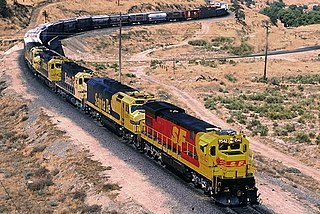
The Santa Fe–Southern Pacific merger was an attempted corporate consolidation of two of the major railroads in the Western United States at the time: the Atchison, Topeka and Santa Fe Railway and the Southern Pacific Railroad. The approximately US$5 billion deal was announced in September 1983 and in December 1983, both companies were acquired by a new holding company, the Santa Fe Southern Pacific Corporation and both companies' extensive non-railroad related assets were immediately combined. However, the Southern Pacific Railroad remained in a voting trust and the railroads continued to be operated independently and competitively while the merger worked through the regulatory process.
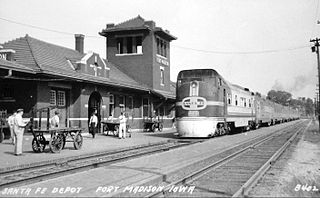
Electro-Motive Corporation produced five 1800 hp B-B experimental passenger train-hauling diesel locomotives in 1935; two company-owned demonstrators, #511 and #512, the Baltimore and Ohio Railroad's #50, and two units for the Atchison, Topeka and Santa Fe Railway, Diesel Locomotive #1. The twin engine power unit layout and multiple unit control systems developed with the B-B locomotives were soon adopted for other locomotives such as the Burlington Route's Zephyr locomotives built by the Budd Company in 1936 and EMC's own EMD E-units introduced in 1937. The B-B locomotives worked as proof-of-concept demonstrators for diesel power with the service loads of full size trains, breaking out of its niche powering the smaller custom Streamliners.

The EMD SD45-2 is a 6-axle diesel-electric locomotive built by General Motors Electro-Motive Division (EMD). EMD built 136 locomotives between 1972 and 1974, primarily for the Atchison, Topeka and Santa Fe Railway (ATSF). The SD45-2 was an improved version of the EMD SD45; the primary visual difference is the absence of flared radiators on the SD45-2.

Atchison, Topeka and Santa Fe 3751 is a class "3751" 4-8-4 "Heavy Mountain" type steam locomotive built in May 1927 by the Baldwin Locomotive Works in Eddystone (Philadelphia), Pennsylvania for the Atchison, Topeka & Santa Fe Railway (ATSF). No. 3751 was the first 4-8-4 steam locomotive built for the Santa Fe and was referenced in documentation as type: "Heavy Mountain", "New Mountain", or "Mountain 4-wheel trailer". No. 3751 served in passenger duties until being retired in 1957.

The "Beep" is an individual switcher locomotive built in 1970 by the Atchison, Topeka and Santa Fe Railway at its Cleburne, Texas, workshops. Technically a rebuild, the Beep originally entered service on the Santa Fe as a Baldwin Model VO-1000. Following its successful CF7 capital rebuilding program, the company hoped to determine if remanufacturing its aging, non-EMD end cab switchers by fitting them with new EMD prime movers was an economically viable proposition. The conversion procedure proved too costly and only the one unit was modified. In 2008-2009, this locomotive was retired and stored operational at Topeka, Kansas. In May 2009 the unit was donated to the Western America Railroad Museum in Barstow, California.
The Oakland Terminal Railway was a terminal railroad in West Oakland, California. The OTR was jointly acquired in 1943 by the Western Pacific Railroad and Atchison, Topeka and Santa Fe Railway to take over the Key System's freight railroad known as the Oakland Terminal Railroad. Today, the OTR is now the West Oakland Pacific Railroad that operates on 10 miles of track. OTR was jointly owned by the Union Pacific Railroad and BNSF Railway. The railroad operated in the industrial area around the Oakland Army Base.
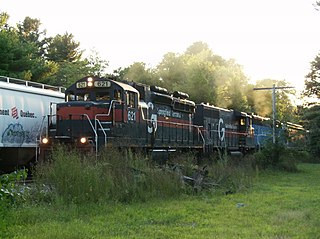
The SD26 were EMD SD24 diesel locomotives rebuilt by the Atchison, Topeka and Santa Fe Railway between January 1973 and January 1978. In an effort to spare the cost of purchasing new motive power, the Santa Fe elected to expand on the success of its CF7 and other capital rebuild programs and extend the life of its fleet of 80 aging SD24s by rebuilding them at its San Bernardino, California Shops.
The FM H-12-44TS was a light road switcher version of the Fairbanks-Morse H-12-44 yard switcher locomotive. Only three of the 1,200-horsepower (890 kW), six-cylinder opposed piston engine locomotives were manufactured especially for the Atchison, Topeka and Santa Fe Railway in May, 1956. The units had an extended frame to accommodate the addition of a short hood behind the cab, and were configured in a B-B wheel arrangement and mounted atop a pair of two-axle AAR Type-A switcher trucks with all axles powered. H-12-44TSs also came equipped with steam generator units as they were acquired solely for shuttling passenger cars in and around the Dearborn Station terminal in Chicago, Illinois.

The Santa Fe, Prescott and Phoenix Railway (SFP&P) was a common carrier railroad that later became an operating subsidiary of the Atchison, Topeka and Santa Fe Railway in Arizona. At Ash Fork, Arizona, the SFP&P connected with Santa Fe's operating subsidiary, the Atlantic & Pacific Railroad mainline, that ran from California to Chicago. The SFP&P's 195-mile (314 km) line extended the Santa Fe Railway south into Phoenix. The SFP&P extended another 100 miles (160 km) to the east from Phoenix to Florence and Winkelman via the Phoenix and Eastern Railroad. The SFP&P also served several mines in the Prescott area, including the Derby Mine by way of the Summit (flag) Station at 'Prieta' in the Sierra Prieta range, through its various subsidiary railroads.
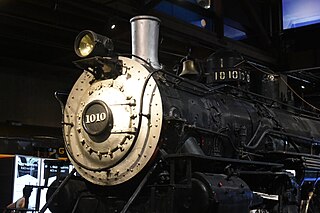
Atchison, Topeka and Santa Fe Railway No. 1010 is a 2-6-2 type steam locomotive built by the Baldwin Locomotive Works in 1901 for Atchison, Topeka and Santa Fe Railway. It started out as a Vauclain compound locomotive before it was rebuilt into a conventional locomotive in the 1910s. It was primarily used for various passenger trains across the Southwestern United States, including the record breaking 1905 Scott Special on the segment between Needles, California, and Seligman, Arizona, before it was reassigned to freight service in the 1940s. It was retired in 1955 and was kept by the Santa Fe for several years for preservation purposes. In 1979, Santa Fe donated No. 1010 to the California State Railroad Museum, where the locomotive resides there in Sacramento as of 2023.
The Valley Flyer was a short-lived named passenger train of the Atchison, Topeka and Santa Fe Railway. The all-heavyweight, "semi-streamlined" train ran between Bakersfield and Oakland, California during the 1939–1940 Golden Gate International Exposition on Treasure Island in San Francisco Bay. Motive power was two Baldwin-built 1300 class 4-6-2 "Pacific" locomotives refurbished and decorated for the train. It was the Santa Fe's first attempt at streamlining older steam power.

The Great Plains Transportation Museum is a railroad museum in Wichita, Kansas, United States.

The Southern California Railway Museum, formerly known as the Orange Empire Railway Museum, is a railroad museum in Perris, California, United States. It was founded in 1956 at Griffith Park in Los Angeles before moving to the former Pinacate Station as the "Orange Empire Trolley Museum" in 1958. It was renamed "Orange Empire Railway Museum" in 1975 after merging with a museum then known as the California Southern Railroad Museum, and adopted its current name in 2019. The museum also operates a heritage railroad on the museum grounds.
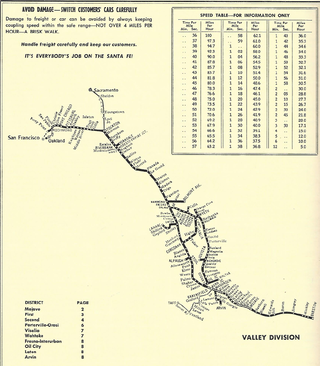
The Valley Division of the Atchison, Topeka and Santa Fe Railway ran from San Francisco to Barstow in California. It is currently in operation as the BNSF Railway's Stockton Subdivision and Bakersfield Subdivision.

Atchison, Topeka and Santa Fe No. 769 is a preserved 769 class 2-8-0 "consolidation" type steam locomotive originally built by the Richmond Locomotive Works in 1900 as one of the Santa Fe Pacific Railroad's final locomotives. It was originally numbered 266 before the SFP had completely merged into its parent company, the Atchison, Topeka and Santa Fe Railway, and the locomotive was renumbered 3045, and it was eventually renumbered again to 769. The locomotive was put into use for short-distance freight trains and for yard switching before being sold again in 1950 to the Albuquerque and Cerrillos Coal Company in Madrid, New Mexico for more yard switching and short distance coal trains. As the 1950s progressed, however, the company shut down due to bankruptcy, and No. 769 was abandoned along with the rest of the locomotive yard and the rest of Madrid. In the late 1970s the town was recovered and converted into a heritage town, and No. 769 was then put on static display just behind the shed it was stored in, which was converted to the Engine House Theatre. In early 2020, No. 769 was selected for a future project to restore it to operating condition to eventually run on reconstructed trackage between Madrid and a nearby BNSF interchange near Los Cerrillos.